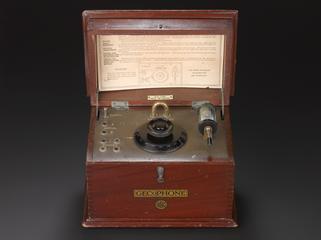John Logie Baird's original experimental television apparatus, 1925-1926
Transmitting portion of original television experimental apparatus, created and used by John Logie Baird, with a dummy head of "Stookie / Stooky Bill". 1925-1926.
More
This original Television apparatus was made of 16 lenses fitted in two half-spirals on a cardboard disc cut from a hat box. This was connected to a large motor mounted on an old tea chest which turned the disc. As the disc rotated, each of the lenses scanned a different part of the subject and focused light into Baird's secret photosensitive cell, where it was turned into an electrical signal which could be sent to a receiver.
Receiving equipment had a similar disc and showed small but recognisable images of human faces with 32 lines of resolution on a ground glass screen. The light was provided by a neon tube which shone through the spinning receiver disc onto the glass.
John L Baird succeeded in transmitting the silhouette in 1923 and the full recognisable image in 1925. During the experiment, a dummy head called ‘Stooky Bill’ was used as the apparatus would become too hot for humans.
- Materials:
- wood (unidentified) , aluminium (metal) , cardboard , electrical components , glass , plaster of Paris , hair and paint
- Object Number:
- 1926-1040/1
- type:
- television and equipment





